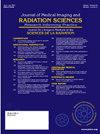Developing and validating a multi-omics prediction model for severe acute oral mucositis in nasopharyngeal carcinoma patients undergoing radiation therapy
IF 1.3
Q3 RADIOLOGY, NUCLEAR MEDICINE & MEDICAL IMAGING
Journal of Medical Imaging and Radiation Sciences
Pub Date : 2024-10-01
DOI:10.1016/j.jmir.2024.101548
引用次数: 0
Abstract
Background
Oral mucositis is a common and painful toxicity which can severely affect patients’ quality of life. This study focused on developing and externally validating a prediction model for severe acute oral mucositis (OM) in nasopharyngeal carcinoma (NPC) patients undergoing radiation therapy (RT). We attempted to harness pre-treatment clinical, dose-volume-histogram (DVH), radiomic and dosiomic features to better predict the occurrence of severe OM.
Methods
A retrospective analysis of 464 histologically confirmed NPC patients treated at two public institutions in Hong Kong was performed. Model development and internal validation was conducted on institution A (N=363) and external validation was evaluated on institution B (N=101). Severe OM was defined as the occurrence of CTCAE/RTOG grade 3 or higher during treatment. Two predictive models were constructed: 1) conventional clinical and DVH features, and 2) a multi-omics approach to include clinical, DVH, radiomic, and dosiomic features. Both models underwent rigorous optimization, involving mRMR feature selection, data scaling and model fitting conducted within 20-fold cross-validation on institution A.
Results
The multi-omics model outperformed the conventional model in internal and external validation. Specifically, the multi-omics model achieved area under the receiver-operating characteristic curve (AUC) scores of 0.67 (0.61, 0.73), and 0.65 (0.53, 0.77) respectively, compared to the conventional model's scores of 0.63 (0.56, 0.69) and 0.56 (0.44, 0.67). The 95% confidence intervals show that only the multi-omics model significantly outperformed random guessing (AUC=0.5) in external validation.
Conclusion
These findings suggest that radiomics and dosiomics features, by quantifying pre-treatment tissue radiodensity and spatial dose distribution, can enable better identification of patients at risk of severe OM. Further exploration of radiomics and dosiomics-based prediction models is warranted to facilitate improved clinical decision-making, thereby enabling more personalized care for the prevention and management of OM.
开发并验证接受放射治疗的鼻咽癌患者严重急性口腔黏膜炎的多组学预测模型
背景口腔黏膜炎是一种常见且痛苦的毒性反应,会严重影响患者的生活质量。本研究的重点是开发并从外部验证接受放射治疗(RT)的鼻咽癌(NPC)患者严重急性口腔黏膜炎(OM)的预测模型。我们试图利用治疗前的临床、剂量-体积-组图(DVH)、放射学和剂量学特征来更好地预测严重口腔黏膜炎的发生。A机构(363人)进行了模型开发和内部验证,B机构(101人)进行了外部验证评估。严重 OM 的定义是在治疗过程中出现 CTCAE/RTOG 3 级或以上。构建了两个预测模型:1)传统的临床和 DVH 特征;2)包含临床、DVH、放射学和剂量组学特征的多组学方法。两个模型都经过了严格的优化,包括 mRMR 特征选择、数据缩放和模型拟合,并在机构 A 上进行了 20 倍交叉验证。具体来说,与传统模型的 0.63(0.56, 0.69)和 0.56(0.44, 0.67)相比,多组学模型的接受者工作特征曲线下面积(AUC)分别达到了 0.67(0.61, 0.73)和 0.65(0.53, 0.77)。95%置信区间显示,在外部验证中,只有多组学模型的表现明显优于随机猜测(AUC=0.5)。结论这些研究结果表明,通过量化治疗前的组织放射密度和空间剂量分布,放射组学和剂量组学特征可以更好地识别有严重 OM 风险的患者。有必要进一步探索基于放射组学和剂量组学的预测模型,以促进临床决策的改进,从而为预防和管理OM提供更加个性化的医疗服务。
本文章由计算机程序翻译,如有差异,请以英文原文为准。
求助全文
约1分钟内获得全文
求助全文
来源期刊

Journal of Medical Imaging and Radiation Sciences
RADIOLOGY, NUCLEAR MEDICINE & MEDICAL IMAGING-
CiteScore
2.30
自引率
11.10%
发文量
231
审稿时长
53 days
期刊介绍:
Journal of Medical Imaging and Radiation Sciences is the official peer-reviewed journal of the Canadian Association of Medical Radiation Technologists. This journal is published four times a year and is circulated to approximately 11,000 medical radiation technologists, libraries and radiology departments throughout Canada, the United States and overseas. The Journal publishes articles on recent research, new technology and techniques, professional practices, technologists viewpoints as well as relevant book reviews.
 求助内容:
求助内容: 应助结果提醒方式:
应助结果提醒方式:


